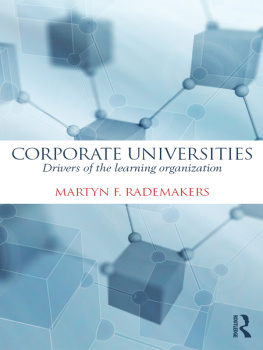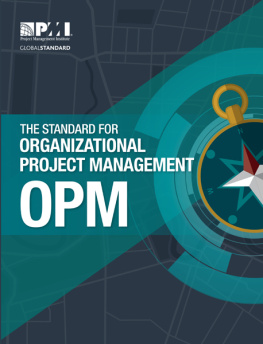
More Praise for Designing the Smart Organization
A path-breaking work! Deiser creatively uses learning theory and practice to recast the practice of strategic management and demonstrates the concept through remarkable case studies from ten prominent companies.
Larry Greiner, coauthor, Management Consulting Today
and Tomorrow and Dynamic Strategy-Making
Deiser clearly, effectively and accurately points out how organizations must reframe how they design learning processes to thrive in todays rapidly changing world. A variety of interesting cases show how to do it.
Edward E. Lawler III, director,
Center for Effective Organizations,
USC Marshall School of Business, and coauthor,
Built to Change
A truly insightful book that I highly recommend for any corporate leader, senior executive, or consultant involved in strategy, organizational change, innovation, or HR who is looking to create organizations that last. Deiser makes us not only look at the practice of learning with new eyes, but he also tells a variety of concrete case stories from major global players that flesh out the concepts of this book with great clarity and relevance.
Daniel Dirks, executive vice president
and global head of human resources, Allianz Group
Deiser does an excellent job in making us think about learning in novel waysas an enabler of organizational change, cultural unifi cation, strategic renewal, or just plain survival. Everybody who wants to make a difference in business, government, or other organizational worlds should read this book.
Immanuel Hermreck,
executive vice president human resources,
Bertelsmann AG
We are pleased to offer a free downloadable Instructors Manual for Designing the Smart Organization, including sample syllabi, chapter summaries, and additional case study materials, as well as chapter-by-chapter comprehension questions, in-class discussion questions, essay prompts, and PowerPoint slides.
To access the manual, please visit www.wiley.com/college/deiser
Copyright 2009 by John Wiley & Sons, Inc. All rights reserved.
Published by Jossey-Bass
A Wiley Imprint
989 Market Street, San Francisco, CA 94103-1741www.josseybass.com
No part of this publication may be reproduced, stored in a retrieval system, or transmitted in any form or by any means, electronic, mechanical, photocopying, recording, scanning, or otherwise, except as permitted under Section 107 or 108 of the 1976 United States Copyright Act, without either the prior written permission of the publisher, or authorization through payment of the appropriate per-copy fee to the Copyright Clearance Center, Inc., 222 Rosewood Drive, Danvers, MA 01923, 978-750-8400, fax 978-646-8600, or on the Web at www.copyright.com. Requests to the publisher for permission should be addressed to the Permissions Department, John Wiley & Sons, Inc., 111 River Street, Hoboken, NJ 07030, 201-748-6011, fax 201-748-6008, or online at www.wiley.com/go/permissions.
Readers should be aware that Internet Web sites offered as citations and/or sources for further information may have changed or disappeared between the time this was written and when it is read.
Limit of Liability/Disclaimer of Warranty: While the publisher and author have used their best efforts in preparing this book, they make no representations or warranties with respect to the accuracy or completeness of the contents of this book and specifically disclaim any implied warranties of merchantability or fitness for a particular purpose. No warranty may be created or extended by sales representatives or written sales materials. The advice and strategies contained herein may not be suitable for your situation. You should consult with a professional where appropriate. Neither the publisher nor author shall be liable for any loss of profit or any other commercial damages, including but not limited to special, incidental, consequential, or other damages.
Jossey-Bass books and products are available through most bookstores. To contact Jossey-Bass directly call our Customer Care Department within the U.S. at 800-956-7739, outside the U.S. at 317-572-3986, or fax 317-572-4002.
Jossey-Bass also publishes its books in a variety of electronic formats. Some content that appears in print may not be available in electronic books.
ISBN-13: 978-0-470-49067-9
Cataloging-in-Publication data on file with the Library of Congress.
FIRST EDITION
Figures and Exhibits
Figures (Part One)
Exhibits (Part Two)
For Kathrin, David, and Una
Introduction
It has become common sense that the competitive success, if not the mere survival, of most of todays organizations is in large part dependent on their ability to learn, to innovate, and to change on an ongoing, sometimes radical basis. Given this, one might think that the learning imperative would have already led to a steep rise in the importance and reputation of corporate learning and development activities as a key strategic organizational practice, on equal footing with finance or marketing and high on the agenda of the Chief Executive Officer (CEO).
However, in most companies the corporate learning agenda is still struggling to get an adequate voice in the boardroom. The practice of learning does not have a seat at the table when it comes to shaping the business. The Vice President of Learning and Development is usually part of a Human Resource (HR) function that itself suffers in most organizations from a lack of clout and perceived business relevance. The fact that some companies have introduced Chief Learning Officers (CLOs) or even corporate universities seems to suggest otherwise, but a little scratching on the surface reveals that, in many cases, its just a new label for the old training department.
The primary reason for the ongoing marginalization of learning is that the debate about the value and contribution of learning is driven by a restrictive understanding of the practice, one that has its roots in a school-based approach to qualification and training. While traditional education and people development remain important, the true challenge large organizations face today is to create and manage enabling architectures that systematically build strategic and organizational capabilitiessuch as speed, responsiveness, responsibility, innovation, and creativityinto the companys DNA.
This leads us to a new and ambitious concept of corporate learning that has little to do with the traditional notion of training and education. As a transformational business practice, corporate learning has to leave the classroom and become a business practice, with the focus on initiatives that nurture, develop, and leverage a companys strategic competence.
To support this argument, we will look at the universe of learning with fresh lenses. We will show that it is not just a back-end qualification process; the very nature of learning is rather about innovation, change, and transformation. Learning is not just about the acquisition of cognitive and technical skills; it includes social, political, and ethical competences. It doesnt happen only in the classroomclassrooms are actually pretty dysfunctional learning contextsit occurs everywhere because it is at the heart of our daily struggle to make sense of the world and succeed in complex contexts. And most important, learning is not restricted only to individuals; it is a fundamental process that drives the development of large-scale systems. Using learning to acquire personal skills and insights is great and important. But the learning challenge of the twenty-first century is much greater: How can entire corporations, industries, even societies learn to be more strategically competent systems, so that they will ultimately survive in balance within their relevant ecosystem?
Next page





